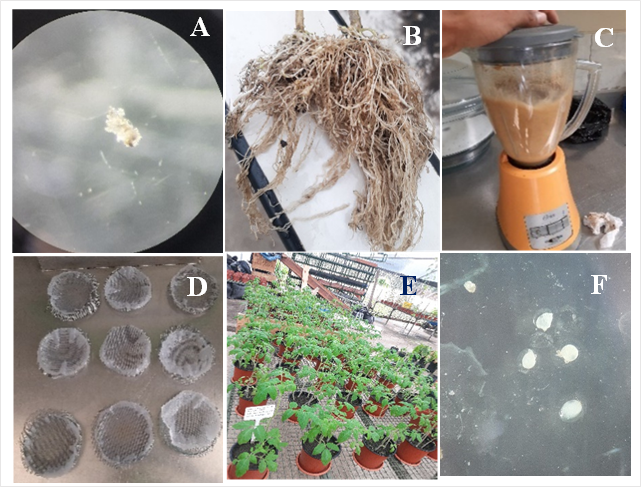Rapid molecular detection of root-knot nematode Meloidogyne incognita in coffee (Coffea arabica L.) roots
DOI:
https://doi.org/10.51252/raa.v4i2.737Keywords:
DNA, molecular biology, specific primers, phytoparasitesAbstract
Coffee is one of the most relevant agricultural products globally, due to its significant economic, social and environmental impact, especially in producing countries such as Peru. In particular, the San Martín region stands out for its production of 83425 tons of parchment coffee in an area of 81000 hectares. Root-knot nematodes, especially of the genus Meloidogyne, are a significant threat to coffee cultivation, affecting plant water and nutrient uptake. Accurate and rapid detection of these nematodes is crucial for their effective control. The objective was based on the rapid molecular detection of the root-knot nematode Meloidogyne incognita in coffee roots by PCR with the specific primers MI-F and MI-R to amplify a band of 999 bp. The isolation of DNA allowed concentrations between 59.1 to 39.4 ng/µL and absorbance ranges from 1.92 to 2.00, being determined as good quality DNA. This study focuses on the molecular detection of M. incognita in coffee roots. These results allow accurate and rapid detection of nematodes in coffee, and thus be able to control this pathogen in time.
Downloads
References
Campos, V. P., & Villain, L. (2005). Nematode parasites of coffee and cocoa. En Plant parasitic nematodes in subtropical and tropical agriculture (pp. 529–579). CABI Publishing. https://doi.org/10.1079/9780851997278.0529 DOI: https://doi.org/10.1079/9780851997278.0529
Chitambar, J. J., Westerdahl, B. B., & Subbotin, S. A. (2018). Plant Parasitic Nematodes in California Agriculture (pp. 131–192). https://doi.org/10.1007/978-3-319-99585-4_6 DOI: https://doi.org/10.1007/978-3-319-99585-4_6
Coyne, D. L., Fourie, H. H., & Moens, M. (2009). Current and future management strategies in resource-poor farming. En Root-knot nematodes (pp. 444–475). CABI. https://doi.org/10.1079/9781845934927.0444 DOI: https://doi.org/10.1079/9781845934927.0444
Doyle, J. J., & Doyle, J. L. (1987). A rapid DNA isolation procedure for small quantities of fresh leaf tissue. Phytochemical bulletin, 19(1), 11–15.
Elling, A. A. (2013). Major Emerging Problems with Minor Meloidogyne Species. Phytopathology, 103(11), 1092–1102. https://doi.org/10.1094/PHYTO-01-13-0019-RVW DOI: https://doi.org/10.1094/PHYTO-01-13-0019-RVW
FAO. (2019). The State of Food and Agriculture - 2019. Food and Agriculture Organization of the United Nations. https://www.fao.org/state-of-food-agriculture/2019/pt/
Gelpud Chaves, C., Mora Marcillo, E., Salazar González, C., & Betancourth Garcia, C. (2011). Susceptibilidad de genotipos de Solanum spp. al nematodo causante del nudo radical Meloidogyne spp. (chitwood). Acta Agronómica, 60(1), 50–67. https://revistas.unal.edu.co/index.php/acta_agronomica/article/view/21157
Holterman, M., Karssen, G., van den Elsen, S., van Megen, H., Bakker, J., & Helder, J. (2009). Small Subunit rDNA-Based Phylogeny of the Tylenchida Sheds Light on Relationships Among Some High-Impact Plant-Parasitic Nematodes and the Evolution of Plant Feeding. Phytopathology, 99(3), 227–235. https://doi.org/10.1094/PHYTO-99-3-0227 DOI: https://doi.org/10.1094/PHYTO-99-3-0227
ICO. (2021). Coffee Development Report 2021. https://www.ico.org/documents/cy2022-23/coffee-development-report-2021.pdf
Janssen, T., Karssen, G., Verhaeven, M., Coyne, D., & Bert, W. (2016). Mitochondrial coding genome analysis of tropical root-knot nematodes (Meloidogyne) supports haplotype based diagnostics and reveals evidence of recent reticulate evolution. Scientific Reports, 6(1), 22591. https://doi.org/10.1038/srep22591 DOI: https://doi.org/10.1038/srep22591
Jones, J. T., Haegeman, A., Danchin, E. G. J., Gaur, H. S., Helder, J., Jones, M. G. K., Kikuchi, T., Manzanilla‐López, R., Palomares‐Rius, J. E., Wesemael, W. M. L., & Perry, R. N. (2013). Top 10 plant‐parasitic nematodes in molecular plant pathology. Molecular Plant Pathology, 14(9), 946–961. https://doi.org/10.1111/mpp.12057 DOI: https://doi.org/10.1111/mpp.12057
Lopez-Lima, D., Sánchez-Nava, P., Carrion, G., Espinosa de los Monteros, A., & Villain, L. (2015). Corky-root symptoms for coffee in central Veracruz are linked to the root-knot nematode Meloidogyne paranaensis, a new report for Mexico. European Journal of Plant Pathology, 141(3), 623–629. https://doi.org/10.1007/s10658-014-0564-9 DOI: https://doi.org/10.1007/s10658-014-0564-9
Lucena-Aguilar, G., Sánchez-López, A. M., Barberán-Aceituno, C., Carrillo-Ávila, J. A., López-Guerrero, J. A., & Aguilar-Quesada, R. (2016). DNA Source Selection for Downstream Applications Based on DNA Quality Indicators Analysis. Biopreservation and Biobanking, 14(4), 264–270. https://doi.org/10.1089/bio.2015.0064 DOI: https://doi.org/10.1089/bio.2015.0064
MINAGRI. (2020). Análisis de la producción de café en el Perú. Ministerio de Agricultura y Riego.
Qing-peng, M., Hai, L., & Jian-hua, X. (2004). PCR Assays for Rapid and Sensitive Identification of Three Major Root-Knot Nematodes, Meloidogyne incognita,M. javanica and M. arenaria. Acta Phytopathologica Sinica, 34(3), 204–210. http://zwblxb.magtech.com.cn/EN/Y2004/V34/I3/204
Saikai, K. K., Oduori, C., Situma, E., Njoroge, S., Murunde, R., Kimenju, J. W., Miano, D. W., Haukeland, S., & Coyne, D. (2023). Biocontrol-based strategies for improving soil health and managing plant-parasitic nematodes in coffee production. Frontiers in Plant Science, 14. https://doi.org/10.3389/fpls.2023.1196171 DOI: https://doi.org/10.3389/fpls.2023.1196171
Wesemael, W., Viaene, N., & Moens, M. (2011). Root-knot nematodes (Meloidogyne spp.) in Europe. Nematology, 13(1), 3–16. https://doi.org/10.1163/138855410X526831 DOI: https://doi.org/10.1163/138855410X526831
Ye, W., Zeng, Y., & Kerns, J. (2015). Molecular Characterisation and Diagnosis of Root-Knot Nematodes (Meloidogyne spp.) from Turfgrasses in North Carolina, USA. PLOS ONE, 10(11), e0143556. https://doi.org/10.1371/journal.pone.0143556 DOI: https://doi.org/10.1371/journal.pone.0143556

Downloads
Published
How to Cite
Issue
Section
License
Copyright (c) 2024 Huber Castillo-García

This work is licensed under a Creative Commons Attribution 4.0 International License.
The authors retain their rights:
a. The authors retain their trademark and patent rights, as well as any process or procedure described in the article.
b. The authors retain the right to share, copy, distribute, execute and publicly communicate the article published in the Revista Agrotecnológica Amazónica (RAA) (for example, place it in an institutional repository or publish it in a book), with an acknowledgment of its initial publication in the RAA.
c. Authors retain the right to make a subsequent publication of their work, to use the article or any part of it (for example: a compilation of their works, notes for conferences, thesis, or for a book), provided that they indicate the source of publication (authors of the work, journal, volume, number and date).









